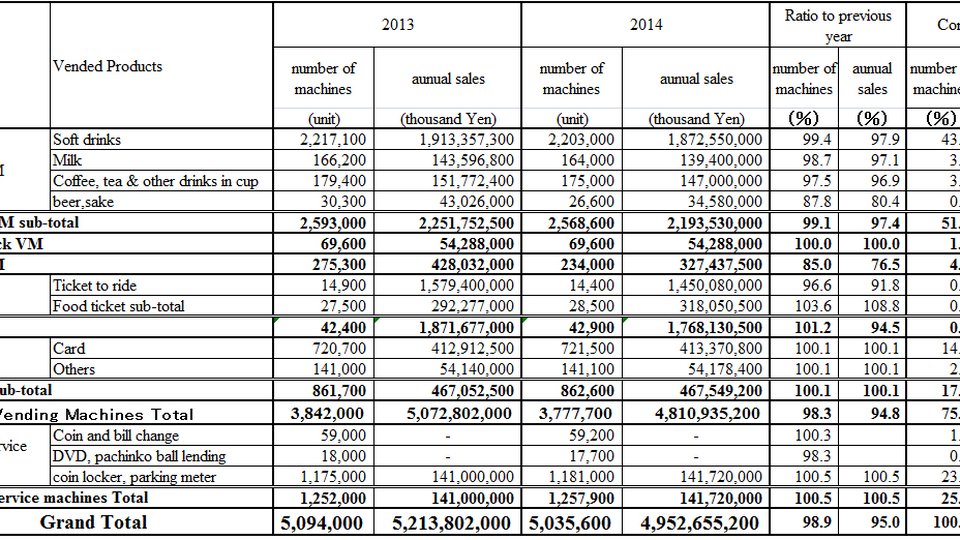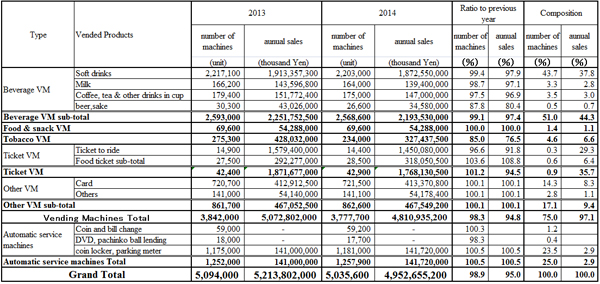News
Japans 2014 Vended Drink Sales Dip Food Holds Steady

May 31, 2015
TAGS: vending machine, Japanese vending industry, Japanese Vending Machine Manufacturers Association, JVMA vending census, food ticket vending machines, pachinko ball lending, beer vending machine, sake vending, JVMA director general, Takashi Kurosaki, Japan's vending industry study, how many vending machines in Japan |
TOKYO -- The Japanese vending industry continues to deal with the aftereffects of the past decade's global financial crisis, as well as the disastrous earthquake and inundations of 2011. Japan's gross national product reached its all-time high in the second quarter of 2007, and the gross domestic product for that year increased 2.2% from the prior year. GDP contracted 5.5% in 2009, recovered strongly in the following year and then contracted 4.7% in 2011. Gross domestic product increased modestly in 2013 (up 1.5%) and more modestly (up 0.9%) in the following year.
A study of Japan's vending performance reflects the nation's sluggish economic recovery. The Japanese Vending Machine Manufacturers Association's annual compilation reported that total vending sales fell 5% in 2014, inching down from 2013's ¥5.214 trillion ($42.9 billion at the current exchange rate) to ¥4.953 trillion ($40.7 billion) last year. Machines on location dipped 1.1% to 5,035,600 from 5,094,000 in 2013.
JVMA tallies a wide range of self-service equipment in its annual studies, including service machines like bill and coin changers, coin-controlled lockers and parking meters, along with public-transportation fare card venders. Some of its vending categories have no U.S. counterparts, such as food tickets (purchased in advance of restaurant meals) and pachinko ball lending apparatuses.
Among the categories of consumable products sold through automated devices, beverages generate the lion's share of vended sales. Soft drink sales in 2014 totaled ¥1.87 trillion ($15.4 billion), a downtick of 2.1% from 2013 sales of ¥1.91 trillion ($15.7 billion). Soft drink vending machines on location contracted by 0.6%, from 2,217,100 in 2013 to 2,203,000 venders in the field last year.
The volume of vended beverages dispensed in cups declined from 2013's ¥151.8 billion ($1.25 billion) to ¥147.0 billion ($1.21 billion) in 2014. The number of cup beverage venders in use fell 2.5%, from 179,400 machines in 2013, to 175,000 last year.
Food and snack venders held their own between 2013 and 2014, with 69,000 machines on location in both years, and volume holding steady at ¥54.9 billion ($446.8 million) in each. And sales through food-ticket venders increased from ¥292.0 billion ($2.4 billion) in 2013 to a robust ¥318.1 billion ($2.6 billion) in 2014, or 8.8%. There were 28,500 of these ticket machines in the field in 2014, compared with 27,500 in 2013.
Tobacco vending continues to decline in Japan, as it has in most advanced nations. Volume of vended tobacco products diminished 23.5%, from ¥428 million ($3.5 billion) in 2013 to ¥327 billion ($2.7 billion). Machines on location decreased by 15% from 275,300 in 2013 to 234,000 in 2014.
Also slumping were sales of beer and sake, a category often remarked upon by American visitors to Japan. The number of machines vending these refreshments fell from 30,300 in 2013 to 26,600 last year, and sales eroded from ¥43 billion ($354 million) to ¥34.6 billion ($284 million) between the two years studied, a drop of 12.2% in volume and 2.6% in machines installed.
The number of bill and coin changers in Japan rose 0.7%, from 59,000 in 2013 to 59,200 in 2014.
JVMA director general Takashi Kurosaki spearheads the study of Japan's vending industry. JVMA is based in Tokyo, online at jvma.or.jp and on Facebook at facebook.com/jvmma.



